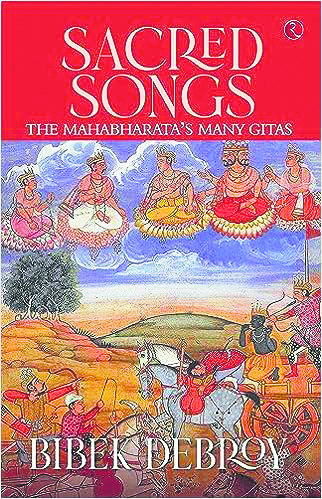In this book, Bibek Debroy has selected 25 Gitas, excluding the Bhagavad Gita, from the Mahabharata.
The Mahabharata, given its encyclopaedic length, unsurprisingly, contains many, many Gitas (songs). Surprisingly though, not many people are aware of the presence of Gitas other than the Bhagavad Gita in the Mahabharata. This book is a selection of 25 Gitas from the Mahabharata, with the Sanskrit verses in Devanagri script, along with their English translation.
Gita means song. When one mentions the word “Gita” in the context of the Mahabharata, one is invariably referring to the Bhagavad Gita—Krishna’s divine message to Arjuna on the eve of the great battle between the Kauravas and Pandavas in Kurukshetra. However, there are other passages that are also called “Gita”. Taken across the Mahabharata, Ramayana, and Puranas, these number over 50. In this book, Bibek Debroy has selected 25 such Gitas, excluding the Bhagavad Gita, from the Mahabharata.
An obvious question that arises is—what are the criteria for classifying a Gita? In the book’s Introduction, several criteria are listed. One is to take only those that are explicitly called out as such in the Critical Edition of the Mahabharata; only nine qualify. Categorizing expositions and conversations that further an understanding of the purushaarthas (dharma, artha, kaama, moksha) are a more acceptable criterion. This brings the list up to 22. Add the Yaksha Prashna and Sanatsujata and you get 24. The 25th is the Pandava (or Prapanna) Gita, added on admittedly weaker grounds.
The Sanatsujata Gita is a remarkable discourse for several reasons. First, it takes place entirely at night. Dhritarashtra is uneasy at the uncertainty the future
Anu Gita, as the name suggests, is supposed to be a repetition of the Bhagavad Gita (“anu” means after, along, with), but is not. Why the Anu Gita? Because Arjuna confesses to Krishna that he has “forgotten everything” that Krishna had told him. A peeved Krishna chides Arjuna for either being forgetful or not intelligent enough. The Bhagavad Gita cannot be repeated, even by Bhagawan, because he had been immersed in a state of yoga when he had revealed to Arjuna the truth about brahman, Vedanta, and more. Nevertheless, he asks Arjuna to ‘hear everything attentively’ as he sets about his discourse. This is the longest of the Gitas in this book, at almost 1000 verses, and is longer than the Bhagavad Gita itself (700 verses).
Then there is the Dharma-Vyadha Gita, or the song of the hunter of Mithila, who proceeds to teach Sage Kaushika about the nature of dharma, the subtleties of non-violence, the dharma of a householder, and the importance of swadharma. This occurs in the Markandeya-samasya upa-parva of Aranyaka Parva, and is an upakhyaana in itself.
One of the most famous episodes in the Mahabharata takes place in the Aranyaka Parva and is the set of questions-and-answers that takes place between Yudhishthira and a Yaksha, and is appropriately called Yaksha-Prashna Gita. On Yudhishthira’s answers to the Yaksha’s question rest the fate of the four Pandavas.
The Nahusha Gita takes place as a dialog between Yudhishthira, again, and Nahusha. Nahusha, an ancestor of the Pandavas, has been expelled from heaven, cursed to take the form of a python (this is itself elaborated in another upakhyaana, recounted by Shalya to Yudhishthira), and has encoiled Bheema. The redemption of both Bheema and Nahusha rests, again, on a dialogue between Yudhishthira and Nahusha. Unlike the Yaksha Prashna Gita, Nahusha here also answers several questions that Yudhishthira poses to him. Nahusha clarifies the difference between the mind and intelligence: “Intelligence is not subject to the different gunas. But the mind has these gunas. Tasks are created from the intelligence, but they are also generated in the mind.” In response to a question by Nahusha on who is a brahmin, Yudhishthira responds that a brahmin “is one in whom truthfulness, charity, forgiveness, good conduct, lack of cruelty and compassion can be seen.” And then “If these traits, not even found in a brahmana, are seen in a shudra, he is not a shudra.” This is one of the strongest arguments put forth against a birth-based assignment of varna (inaccurately translated nowadays as “caste”).
As I wrote earlier, Vidura Gita could have been added. So should have been Ashtavakra Gita, but it has been excised from the Critical Edition, and therefore not included in this book. I have said on many an occasion that reading an unabridged translation is the next best thing to reading the original. Sacred Songs addresses this lacuna by providing the original verses, in Sanskrit—in Devanagari, with an English translation below each verse. Bibek Debroy’s footnotes, at the end of each page, provide additional context and explanation where the constraints of a translation prevent them from being added to the main body. Both casual and serious readers will gain from this collection of sacred songs and hopefully goad the reader into reading the unabridged Mahabharata, for these Gitas are best appreciated in the context they are narrated.
Disclaimer: views expressed are personal.

